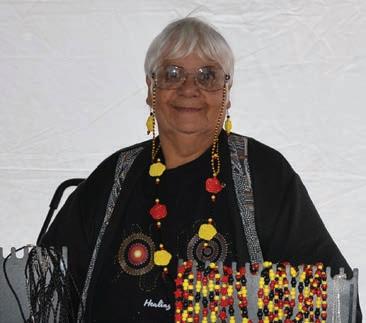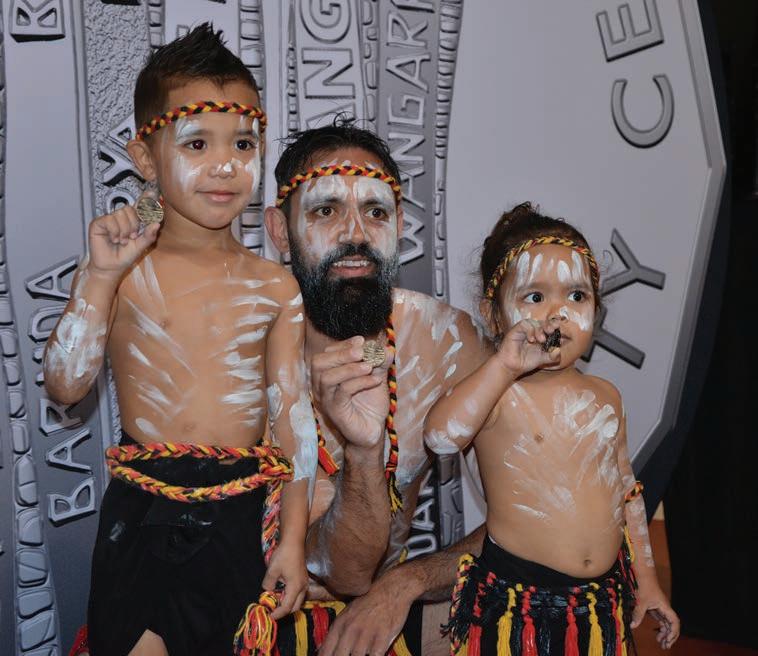
16 minute read
Inside: Valuing Indigenous languages
Australian Indigenous languages are in a ‘dire’ situation, with one language expert predicting that “we won’t have any Australian languages that are strong within the next five years”. Professor Jaky Troy, Director of Aboriginal and Torres Strait Islander Research at the University of Sydney made the comments after the launch of Australia’s newest coin at Tandanya Aboriginal Cultural Institute in Adelaide.
The coin was developed in collaboration with the Australian Institute of Aboriginal and Torres Strait Islander Studies (AIATSIS) with a design featuring languages from 14 Indigenous communities, to mark the United Nations General Assembly’s proclamation that 2019 is the International Year of Indigenous Languages. The 50-cent piece incorporates translations for ‘coin’ from some of the many Indigenous languages in Australia. The design was developed in consultation with language groups from around Australia, including Kaurna and Yankunytjatjara people. The coins were unveiled by AIATSIS CEO and Co-Chair of the UNESCO International Year of Indigenous Languages Steering Committee, Craig Ritchie, Director of Aboriginal and Torres Strait Islander Research at the University of Sydney, Professor Jaky Troy, Kaurna man, Jack Buckskin with his children and Royal Australian Mint CEO, Ross MacDiarmid.
Advertisement
“These coins are a celebration of Australia’s unique and diverse Indigenous languages, we hope the coins will serve as a tangible reminder of the important efforts being undertaken to preserve, protect and revitalise Indigenous languages in Australia” Mr MacDiarmid said at the launch.
Languages are central to the identity of Indigenous Australians and the second National Indigenous Languages Survey conducted in 2014 by AIATSIS recognised that remaining connected to language strengthens well-being and self-esteem in Indigenous communities Mr Ritchie said. “So it’s pretty dire what’s going on” she concluded.
She said that one factor that is not often considered is the role that maintaining language can play in understanding and protecting the natural environment.
“I think one of the biggest issues worldwide is that the languages are not seen to be useful. That somehow speaking English is more useful. That you can get out there and do everything you need to do in your life on English.
“Well you actually can’t.
“If you don’t speak the language of the country that the language belongs to, you lose all the knowledge and information about that country and also how to survive in it.
“If you want to talk about, for example, this environment here we’re in in Adelaide, you want to understand the salt water, the ocean, the bird life, the plants, the trees, the water, you really do need to understand it in Kaurna, not in English, because the Kaurna have been curating this area now for tens and tens of thousands of years. “English in itself does not give you any information about this area here. It can only, at best, do a poor translation of whatever might’ve been shared by the local Indigenous people.”
Professor Troy said that communities need support to speak and maintain their language.
“We need a really concerted effort across Australia to celebrate and actually use our Indigenous languages.
“The whole country really has a responsibility to do that. All people, Aboriginal or not Torres Strait Islander or not.
“The Commonwealth government really does need to put a huge amount of funding into this so that there can be materials out there in our languages. Everything significant that the government does should be translated into language as well. So that’s my feeling” she said.
“Indigenous languages carry more meaning than the words themselves, so too does currency carry meaning beyond its monetary value. The release of these coins is another milestone in recognising the diverse cultures that shape our national story of over 60,000 years” said Mr Ritchie.
Speaking after the launch, Professor Troy said that she welcomed the release of the coin to raise awareness about Australian languages.
“I think one of the great things about this coin is that it’s going to put out into circulation, literally, 14 words from Australian languages.
“These are languages that are strong languages, some of them, that are still spoken on a daily basis and other languages which are in a revival mode or a renewal mode.
“Some of the words on the coin, for money, actually go across several languages.
“So by looking at this coin you can learn a lot about Australian languages, and about the connectedness of the people who speak the languages” she said.
Despite the work that many communities have been doing to revive and strengthen their language, the future for Australian Indigenous languages is not looking promising Professor Troy said.
“The trajectory for Australian Indigenous languages is poor at the moment” she said.
The last published National Indigenous Languages Survey in 2014 identified 13 Australian languages as strong. The previous survey in 2005 had identified 18 strong languages in use.
“So in a space of nine years, we lost five languages” Professor Troy said.
“If we’ve got 13 that are still strong now and we’re losing five languages roughly every decade, we won’t have any Australian languages that are strong within the next 20 years. To see the new 50c coin including information on the languages, go to: www.ramint. gov.au/2019-50c-internationalyear-indigenous-languages
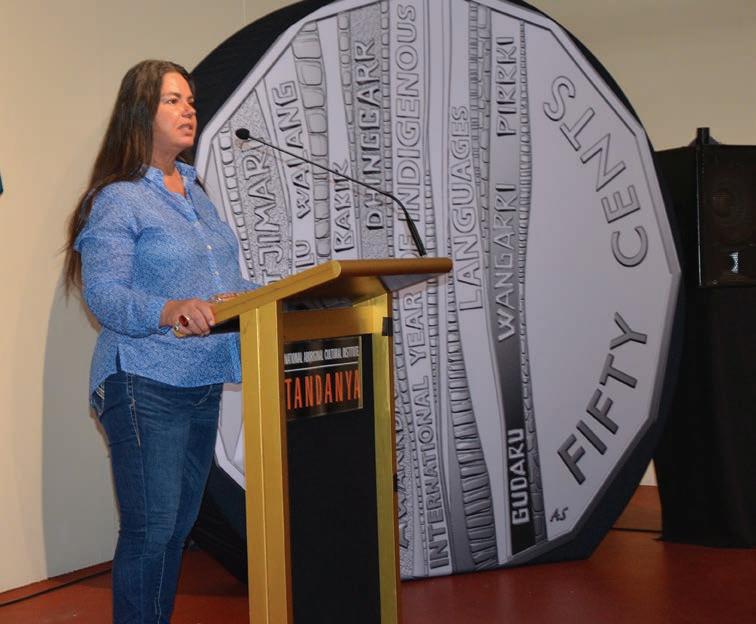

Three hundred and twelve people have been compensated under South Australia’s Stolen Generations Reparations Scheme and the state’s history of forced removal of Aboriginal children has been documented and acknowledged in Parliament.
The final report of the Stolen Generations Reparations Scheme was tabled in SA Parliament on 12 February 2019, with the Premier Mr Steven Marshall presenting the summary of the scheme by Independent Assessor Mr John Hill.
The scheme invited applications for Aboriginal individuals seeking compensation for being forcibly removed from their families as children, as well as funding some projects to support community healing.
Over a two-year period, Assessor Mr Hill heard the stories of around 400 people about their experience of forced removal and the subsequent trauma and loss of family connection and culture.
Mr Hill also investigated and documented South Australia’s legislative and administrative practices that impacted on decisions to take Aboriginal children from their families and place them in often abusive and deprived situations.
Stolen Generations survivors were present to see the tabling of the report in Parliament and hear the Premier acknowledge the past and the resilience of the survivors.
“Mr Hill has found that, while many stolen generation survivors have a sense of grief after enduring physical and mental torture, he observes that most of them also have a generosity of spirit. This speaks eloquently of the resilience of Aboriginal people” Mr Marshall told the Parliament.
“They remain a very proud people despite some of the harrowing episodes in our shared history for which no amount of reparations can ever compensate” he said.
Mr Marshall recommended that “all members of this parliament and the wider community” read the report, in which Mr Hill says:
“There is much for government and society, in general, to reflect on and learn in relation to the policies and practices that produced the Stolen Generations.”
Mr Marshall emphasised that the scheme to compensate stolen generations survivors was a bipartisan project.
“We cannot undo the wrongs of the past, but we can do the right thing now and recognise what was done then, and this parliament has done that. In dealing with this issue, the parliament has worked at its bipartisan best to acknowledge an historic wrong. Arrente woman, Stolen Generations survivor and academic at the University of Adelaide Dr Jennifer Caruso welcomed the conclusion of the scheme.
Dr Caruso had joined other community members in providing advice to Mr Hill throughout the process. She recalls the emotion for Stolen Generations survivors when the scheme was first announced.
“It was emotional because the fact that there was a process also meant that the trauma and the grief rose again. It wasn’t revisiting it because it never, ever leaves us, but it gave rise to it coming to the surface again” Dr Caruso said.
Mr Hill told Aboriginal Way the scheme was initiated by the South Australian Government after national inaction over compensation.
“The Apologies had been made in South Australia a long time ago and at the national level 10 years ago, but there’d been no action taken.
“I think a lot of people thought the Commonwealth should set up a scheme, but it didn’t look like it was ever going to.
“Various committees were established to look at what sort of a scheme could be established in South Australia. The minister Kyam Maher then determined that government would do it by administrative arrangement” Mr Hill explained.
The final report of the scheme emphasises the stories of some of the four hundred survivors who applied for some recognition of their pain and losses. Dr Caruso said it was a powerful approach for the report to take.
“I was speaking to some people who are the children of Stolen Generations yesterday, and they said that reading John Hill’s report, and they couldn’t actually get through that first story.
“The feedback that I had from those people was that it was really, really effective and that children of Stolen Generations and Stolen Generations people feel that their histories have not been subsumed within government rhetoric and reporting rhetoric. It was also an indication that John Hill did really engage with the stories” Dr Caruso said.
Mr Hill reflected on the commonalities in the stories he heard during the scheme.
“I suppose when I first started I had a fairly simplistic view of what may have happened and that there was a kind of a regular kind of process in place where white officials would go out and collect children. But it was much more varied than that. Each individual story was unique.
“Some of the institutions they were put in were very harsh and some of them are just places where they were systematically abused sexually and in other ways. “If they spoke language, they’d often have their mouth washed out with soap or they’d be denied food or they’d be made to sleep in wet bed, a whole lot of things, which were just horrific.”
The stories Mr Hill heard demonstrated that trauma went beyond physical deprivation and abuse he said.
“Many of the people who I interviewed or who I met would say is they never experienced love, so it was very difficult for them when they had their own children to demonstrate that love, to say to their children, ‘I love you’ to hug them, to feel that they were part of a family.
After hearing these stories, Mr Hill reflected on the public reasons behind the removal, “the moral argument that the white community made that we’d given them a better life”.
“They put these kids in so many cases in circumstances which were far worse from the ones that they’d been removed from.
“They were put in with individual families, put into into foster care where there was no cultural awareness or knowledge, there was no language available, there was no connection with family,
“I think the argument just failed completely” Mr Hill said.
The original terms of reference of the scheme required Mr Hill to determine the degree of harm done to individuals and make payments according to that harm. However, that criteria was removed during the process. Mr Hill explained the complexity of such a decision made it impossible.
“In the end it became a little bit difficult to think through, is a baby who’s removed at birth and never even knows they’re Aboriginal, worse or better off than a child of six or seven who’s met their parents and removed?
“How do you compare those harms? It’s just a philosophical question, which is almost impossible to work out.”
“In the end, I put the recommendation, which came from the Stolen Generation Corporation, we gave them all the same amount and everybody seemed happy with that.”
Under the original terms of the scheme, people were not eligible for compensation if they had been removed under a court order.
Mr Hill explained the change to this condition also took place after advocacy from the Stolen Generations Survivors Corporation.
Mr Hill says that reading existing documentation about the experiences of Stolen Generations people, such as the Bringing Them Home report, showed that a court process was not a guarantee of a fair process. “It was clear that even though there may have been a court process and magistrate in a Court out in the bush somewhere with a white police offers or a white doctor a white teacher, even if the parents were there and we’re not sure that they always were, they possibly didn’t really have a clear understanding of what was going on or have the kind of the tools to properly access the legal system in a fair way.”
In tabling the report in parliament, the Premier announced that an additional $10,000 dollars originally set aside for community projects would instead be paid to those stolen generations survivors who were found to be eligible. This final announcement about the scheme took the total payment to each individual to $30,000
“The government believes this is the fairest way to allocate the remaining funding” Mr Marshall said.
I have a diary entry dated 3/5/60 which states child placed at Kate Cox Babies Home. So I was removed from mother’s home – age 16 months. I was removed with my sister and I was told they returned the next day and took the 2 week old baby – so my mother was breast feeding at the time.
My mother told me she was bullied into relinquishing her youngest 3 children under the threat of losing the four older ones. When my mother was stolen her mother was similarly told “Give us the girls and we will let you keep the two boys.”
My birth mother informed me that she requested many times to visit me at Kate Cox Babies Home but permission was never granted.
One story told by a Stolen Generations Survivor to South Australia’s Stolen Generations Reparations scheme Commissioner.
You can read the Final Report of the Stolen Generations Reparation Scheme here: https://www. dpc.sa.gov.au/responsibilities/ aboriginal-affairs-and-reconciliation/ reconciliation/stolen-generationsreparations-scheme
Front cover image, left to right: Brendan Moran, Journey of Healing SA Chair John Browne, Sarah Avey, Keryn Maloney, SA Premier Steven Marshall, Commissioner Roger Thomas, SGRS Independent Assessor the Hon John Hill, Christine Doolan of the SA Circle of Hope, Blackwood Reconciliation Group Chair Allen Edwards, Brian Butler, Lou Turner of the Healing Foundation (SA), Stephanie Gollan, Dr Jenni Caruso of the SA Stolen Generations Aboriginal Corporation, Nerida Saunders, Martha Watts, Kim Morey, Marc Bowden, Maria Atkins and SA Opposition Leader Peter Malinauskas.
Social Justice Commissioner begins term with vital project – Wiyi Yani Thangani (women’s voices)
Aboriginal and Torres Strait Islander Social Justice Commissioner, June Oscar AO has spent the start of her term leading a project that highlights the voices of Aboriginal and Torres Strait Islander women and girls.
The project, called ‘Wiyi Yani U Thangani’ (Women’s Voices) is the first government led initiative to report on Aboriginal and Torres Strait Islander women’s lives since The Women’s Business Report was tabled in Parliament 32 years ago.
As the first woman in the role as Aboriginal and Torres Strait Islander Social Justice Commissioner at the Human Rights Commission, Commissioner Oscar said she felt it was important to meet and speak with Aboriginal and Torres Strait Islander women and girls.
“I felt as an Aboriginal woman and, in this role, I could use it to speak to women about their rights, their human rights and gather information” she said.
Commissioner Oscar said it has been too long since women’s views had been composed in this way.
“It has been such a long time for such an engagement but that’s not to say that women haven’t been contributing to the big issues. Women said that they have been having these conversations for a long time and that is why it is important to gather these opinions in a way that can be turned into action” she said.
The Commissioner said the project was designed for women to speak freely about their lives.
“During 2018, we had the privilege of meeting with 2,294 women and girls in 50 locations across the country, to hear about their strengths, challenges”. announced $1.7 million to support the second stage of the project, as part of the Fourth Action Plan of the National Plan to Reduce Violence Against Women and their Children.
“Stage Two will focus on how First Nations women and girls will use our final Report and its recommendations, as a tool for continuing their incredible work within their communities.
“We want to build on the existing strengths of Aboriginal and Torres Strait Islander women and girls, so that they can work with their communities to lead and negotiate community-led solutions in partnership with government and non-government partners” said Commissioner Oscar.
The Aboriginal and Torres Strait Islander Social Justice Commissioner has been invited to provide an additional proposal to the Federal government for funding to hold a National Summit in 2020.
The National Summit would bring together representatives from the Commonwealth, States and Territories and Aboriginal and Torres Strait Islander peak bodies to work with First Nations women and girls.
Commissioner Oscar said the National Summit would be instrumental in bringing together all participants that have a role in activating the Report’s recommendations and set in motion the development of implementation plans.
Wiyi Yani U Thangani (Women’s Voices), comes from the Bunuba language from around Fitzroy Crossing, the language of Commissioner Oscar’s mother and grandmother.
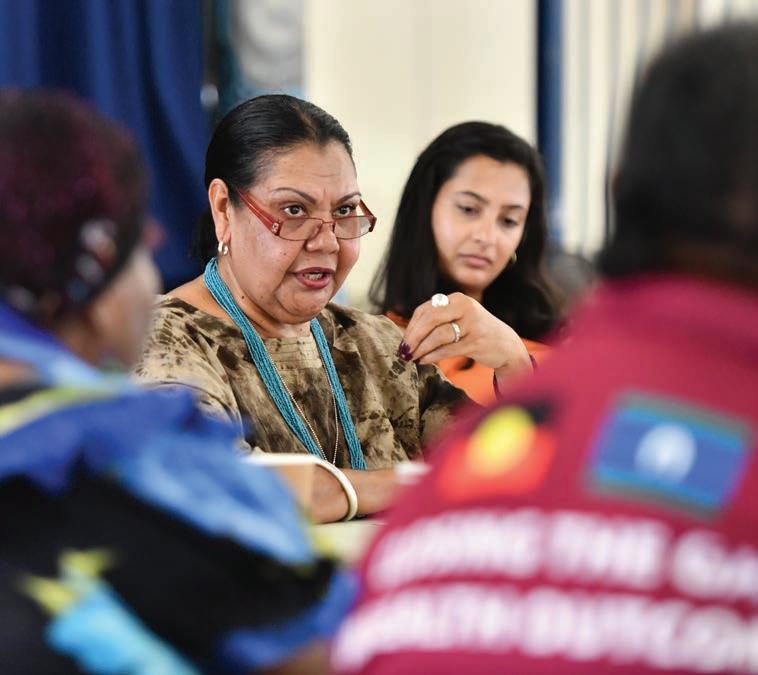
The engagement was an opportunity focused entirely on them. We did not engage with women with any prearranged or set agenda. We simply let them talk about their lives, their lived experiences and what they would like to see change,” said Commissioner Oscar.
The Commissioner said she was grateful to hear from women and girls of all ages and backgrounds.
“We had young women and girls who are still at high school. Those who are attending tertiary level education and those who are in professional jobs, whether they’re lawyers or teachers or managers.
“We also spoke with mothers, with young mums and we were able to speak with the grandmothers and great grandmothers. We had the opportunity of hearing the issues that are unique to a variety of women and girls. To hear their strength and positivity and what their roles are and how they are committed to making a better future, it was truly humbling” said the Commissioner.
Commisioner Oscar said the Wiyi Yani U Thangani project report will be presented to Parliament later this year. The Commissioner said she would like to see action being taken on the issues raised in the report.
“My team and I are currently drafting the report and once completed it will be presented to Parliament. We will then be focused on the need for action based on the report’s recommendations” she said.
In early March, The Federal Minister for Indigenous Affairs Nigel Scullion For more information visit humanrights.gov.au
Honouring the Stolen Generations
On Wednesday 13 February 2019, a community event held at Veale Gardens honoured the Stolen Generations on the 11th anniversary of the National apology.
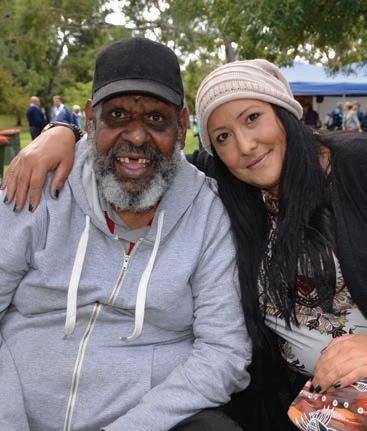

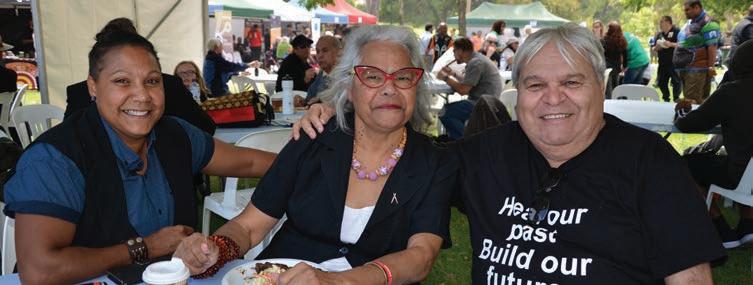
Above, from left: Eddie Peters and Astor Wanganeen; Left to right: Ebony Frankle, Gloria Sumner, Jennie Lelotski, Sharon Rigney, Martha Watts and Jyotsana C; Left to right: Andrea Fraser, Jo Willmot and Jeffrey Cooper; Stephanie Gollan.
